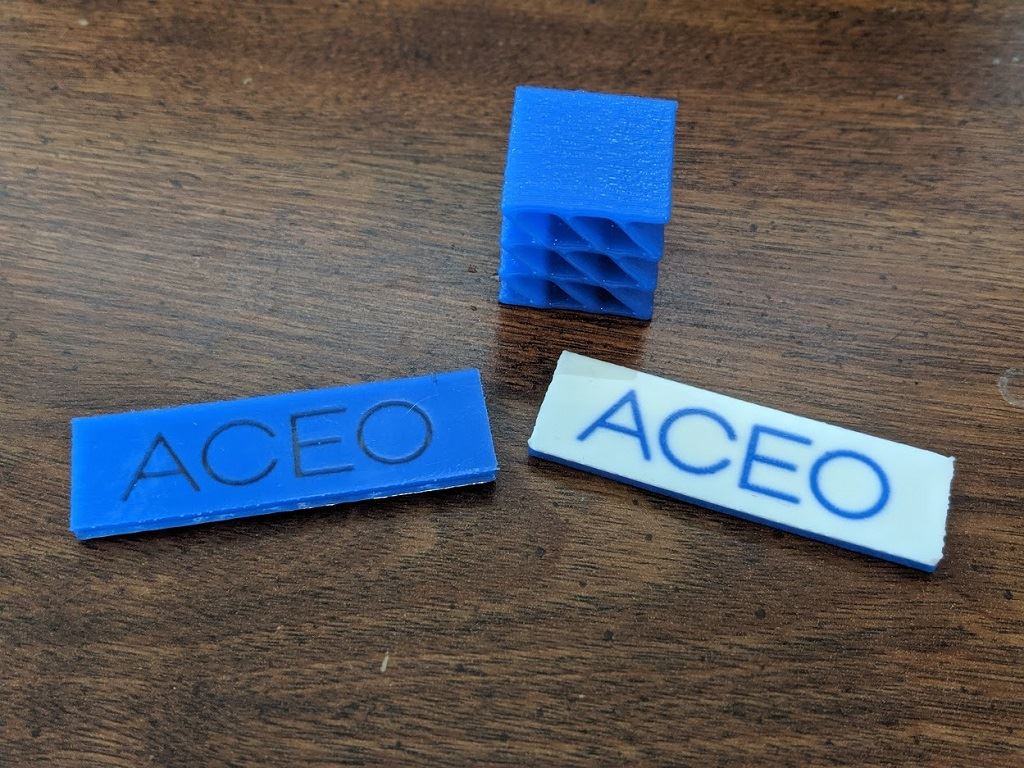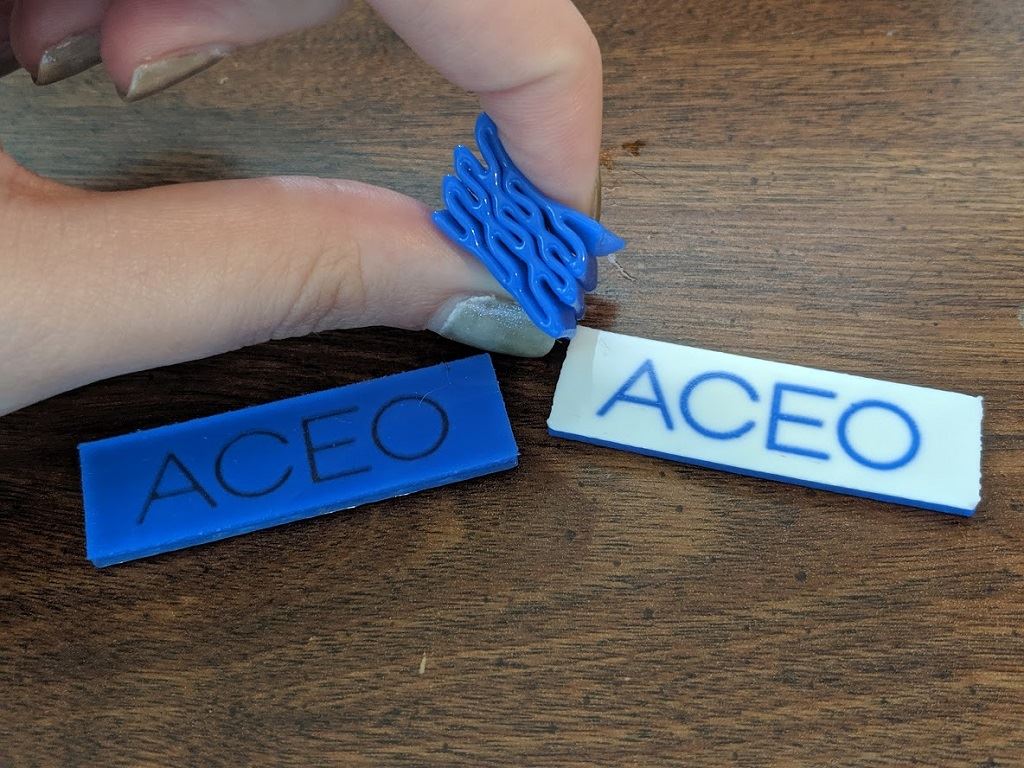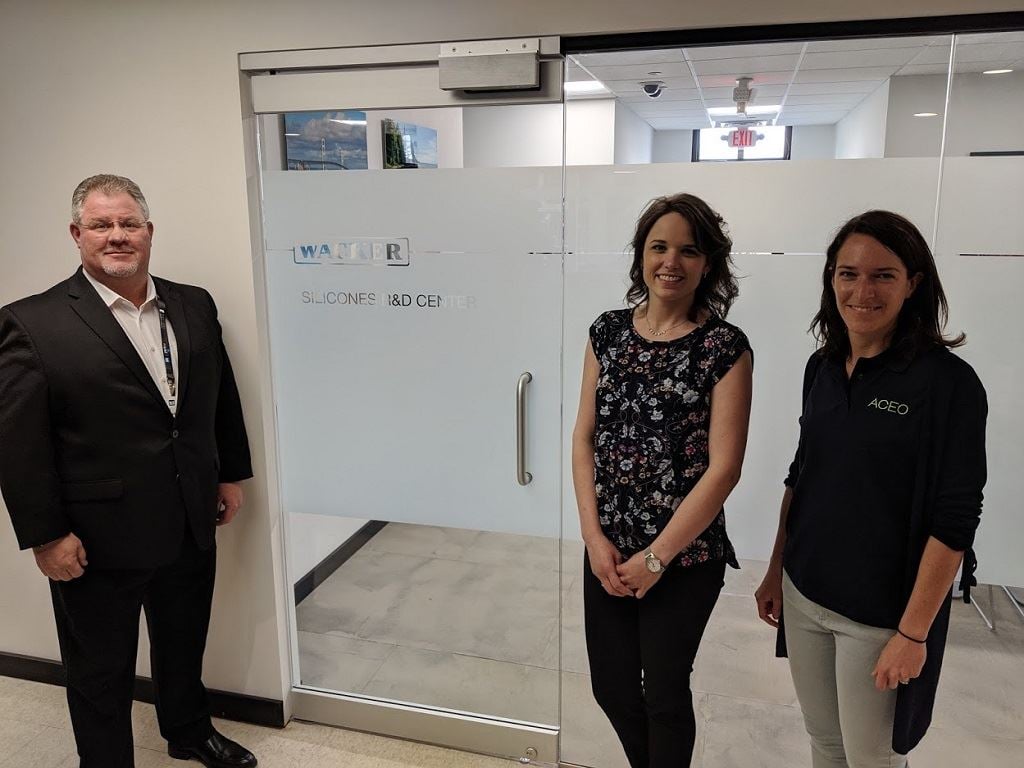![L-R: Ty Larson, Sarah Burke, and Dr. Vera Seitz at Wacker’s R&D site in Ann Arbor, Michigan [Image: Fabbaloo]](https://fabbaloo.com/wp-content/uploads/2020/05/ACEOteam1_img_5eb096b1b9588.jpg)
A look inside ACEO’s US 3D printing operations proved illuminating.
In Ann Arbor, Michigan, about 20 companies share an incubator space. Since 2016, about 10,000 square feet of that space has been dedicated to Wacker Chemie’s R&D operations.
RAPID + TCT this year was located in Detroit, a relatively short drive from Ann Arbor. It was a pleasure to get into town a bit early on the first day of RAPID to accept an invitation from ACEO to go on-site at their lab. We’ve heard about ACEO’s silicone 3D printing abilities for some time now, and have seen their 3D printers at events, but there’s certainly something to be gained from going right into the lab where it happens.
The Ann Arbor 3D printing lab is relatively new still, and run by ACEO Print Lab Manager Sarah Burke, who welcomed another guest and me to the facility. She and Dr. Vera Seitz, a product design engineer based in ACEO’s main campus in Burghausen, Germany, together with Senior Manager of Business Development Ty Larson provided insights into operations and the company’s technology.
![Outside the incubator space [Image: Fabbaloo]](https://fabbaloo.com/wp-content/uploads/2020/05/ACEOsite1_img_5eb096b234133.jpg)
Silicone is a major area of interest in 3D printing. The material offers unique capabilities with applications ranging from medical to industrial. ACEO has been at the forefront of developing viable 3D printing capabilities for the viscous material. Earlier this year they even introduced electrically conductive silicone 3D printing.
ACEO built its own hardware, software, and materials to develop their offerings. The company does not sell 3D printers, but offers services as well as, in Ann Arbor, an Open Print Lab session offering.
“We have developed a systems solution to create the final part,” Seitz explained. “We think it’s the best way to handle it; we have all the parameters in hand, as well as the materials expertise and control over the process.”
Their technology looks a bit like extrusion-based (e.g., FFF/FDM) 3D printing, but is a material dosing, drop-on-demand process. Individual droplets of liquid silicone are placed and merge together; layer by layer, they are then UV-cured.
“We have seen that single droplets offer advantages,” Seitz said of the process. “Drop on demand is our silicone chemistry magic. Single droplets are dosed and have a window to flow and connect, then we cure every layer.”
This is why, Larson added, he calls it “chemical 3D printing.” The monomer crosslinking that occurs this way leads to great strength in the Z-axis, where many 3D printing results can lack.
At ACEO’s lab, the 3D printers are equipped with up to four nozzles, enabling the printing of up to three different silicones and a support material. (The machines we watched start and complete small builds were working with two nozzles.)
The lab works with silicones of various Shore hardnesses — “20-60 Shore A as standard, and aiming for the full silicone range,” Seitz said — and is capable of Pantone color grading. The materials are also biocompatible and food compatible.
“Parts come off the print bed pretty much functional, but we also go one step further and completely cure it at the end. This was a choice made by the company when launching,” Larson said.
That final curing step ensures that parts are indeed completely safe; for example, if a baby came into contact with a part and instinctively put it in her mouth, she wouldn’t be in danger from uncured or toxic chemicals.
Because of the consistent curing, post-processing is minimal. Any supports are easily removed, as they are water-soluble. Supports are generally necessary, as the highly viscous material can’t, for example, create overhangs. The specific material used for the supports is proprietary, but they could say that it is a water-soluble polymer that can be printed on all the same types of materials.


[Silicone prints from ACEO / Images: Fabbaloo]
The multi-material capabilities are, Seitz said, “one of the most fascinating things about 3D printing” from an engineering point of view.
On the drive to Ann Arbor, Larson told the story of a complex stomach model that could be 3D printed with different materials to exactly replicate the feel of human organs within a single model. Surgeons and other medical professionals “learn with their hands,” he said, adding great value to created medical models that precisely replicate anatomy.
The focus at ACEO is, as with the broader 3D printing industry today, on production. Prototyping remains important, but end-use parts are a large part of the future.
The materials used in ACEO’s 3D printing operations are 100% silicone elastomers, “very similar in 3D printing to what is familiar in injection molding as the intrinsic material properties stay the same,” Seitz said. These familiar, proven materials enable that step toward providing functional parts.
That said, ACEO’s capabilities are not ready for full production scale 3D printing. Solutions are still best-fit, and at the moment that means small-volume and just-in-time supply, not runs of millions of parts.
“There will be a time after mass production where 3D printing will be important again, such as for spare parts,” Seitz said, indicating a major use case.
The materials are also sustainable, and produce just ash, no unwelcome byproducts, when burned or destroyed.
ACEO’s 3D printing operations also illustrate one of the more common operations methods we often see with dedicated activities from large organizations. The 3D printing team operates as a sort of well-supported startup with the resources from its large chemical parent. The many decades of expertise developed at Wacker provide a solid starting place for ACEO, including access to advanced silicone know-how. Operations are also quite small; perhaps with 20 people involved between Ann Arbor and Burghausen.
Going into the ACEO R&D lab was a great experience, especially as I had the pleasure of visiting with visual artist and Certified Clinical Anaplastologist Irene Healey, who is familiar from the practical side of working with silicones.
Watching the printers at work (unfortunately I was not able to take photos/video inside the lab), handling prints moments after completion, and getting hands-on with a variety of parts for different applications — even being challenged to break them, even when just one layer thick (Irene and I both failed to do so) — underscored something important. Silicone 3D printing is a very real solution available today, and ACEO’s expertise and early lead in the space make them one to watch (something their approximately 1300 global customers already know).
Via ACEO










